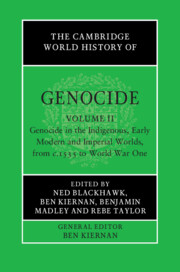Book contents
- The Cambridge World History of Genocide
- The Cambridge World History of Genocide
- The Cambridge World History of Genocide
- Copyright page
- Contents
- Figures
- Maps
- Tables
- Contributors to Volume ii
- Introduction to Volume ii
- Part I Settler Colonialism
- Part II Empire-Building and State Domination
- Part III Nineteenth-Century Frontier Genocides
- 15 The Genocidal French Conquest of Algeria, 1830–1847
- 16 ‘The Bloody Ground’
- 17 ‘A War of Extermination’
- 18 Lessons from Canada
- 19 Frontier Massacres in Australia, 1788–1928
- 20 Genocide in Van Diemen’s Land (Tasmania), 1803–1871
- 21 Genocide in Northern Australia, 1824–1928
- Part IV Premonitions
- Index
20 - Genocide in Van Diemen’s Land (Tasmania), 1803–1871
from Part III - Nineteenth-Century Frontier Genocides
Published online by Cambridge University Press: 23 June 2023
- The Cambridge World History of Genocide
- The Cambridge World History of Genocide
- The Cambridge World History of Genocide
- Copyright page
- Contents
- Figures
- Maps
- Tables
- Contributors to Volume ii
- Introduction to Volume ii
- Part I Settler Colonialism
- Part II Empire-Building and State Domination
- Part III Nineteenth-Century Frontier Genocides
- 15 The Genocidal French Conquest of Algeria, 1830–1847
- 16 ‘The Bloody Ground’
- 17 ‘A War of Extermination’
- 18 Lessons from Canada
- 19 Frontier Massacres in Australia, 1788–1928
- 20 Genocide in Van Diemen’s Land (Tasmania), 1803–1871
- 21 Genocide in Northern Australia, 1824–1928
- Part IV Premonitions
- Index
Summary
The British colonisation of Van Diemen’s Land (later Tasmania) began in 1803. There was an estimated 6,000 Aborigines (Palawa) living on the island with a history dating back over 40,000 years. By 1835, there were just over 100 Palawa living in forced exile on one of Tasmania’s smaller offshore islands. Only two residents remained when the government closed the Aboriginal Settlement in 1871. This chapter traces the history of Tasmania’s colonisation from 1803 to 1871 and finds that the British committed acts against the Palawa that meet the 1948 UN Convention on the Prevention and Punishment of the Crime of Genocide: killings, child removals, and creating conditions unconducive to sustaining life. Tasmania has been cited as one the ‘classical’ cases of genocide, but the finding has also stirred debate. This chapter surveys the historiography of Tasmanian genocide including Raphael Lemkin’s 1940s finding of a clear case of genocide; Henry Reynolds’ 2001 counter evidence of gubernatorial humanitarianism; and the subsequent histories that recognise genocide within the structure of settler colonialism. This chapter concludes that the British committed genocide in Tasmania with intent, but reported and framed that crime within the rhetoric, and even the guidelines, of contemporaneous humanitarian policies.
Keywords
- Type
- Chapter
- Information
- The Cambridge World History of Genocide , pp. 481 - 507Publisher: Cambridge University PressPrint publication year: 2023



